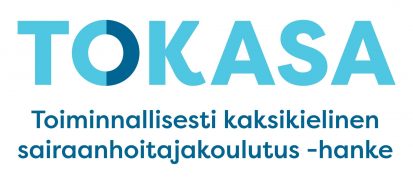Jaa tämä sivu:
The goal of the functionally bilingual nursing education (TOKASA) project is to develop a permanent degree model where Finnish language studies are integrated into subject matter studies. There is no requirement for proficiency in the Finnish language at the application stage; the aim is for the student, upon graduation, to master both the profession and the Finnish language at the level required by the working life. Studies are conducted in both Finnish and English in close collaboration between nursing and Finnish as a Second Language (S2) teachers. One of the key tasks of the TOKASA project is the development and evaluation of the training model. The model of functionally bilingual higher education and key recommendations were published in September 2023. The development work of the model continues based on the experiences and research results obtained until the end of the project. The model is generic and it can be implemented fully or partially in any field of higher education.
The training model consists of seven key elements and related recommendations:
Marketing and entrance exam
It is recommended that:
- Applicants who have successfully completed the written part of the entrance examination should be interviewed to assess their proficiency in the English language.
- Nationally validated entrance exams, such as the international UAS exam, should be used for their reliability and cost-effectiveness.
- Adequate time is allowed between the entrance examination and the start of the education to ensure that all students have time to manage visa processes and other entry-related arrangements.
Language proficiency assessment and language paths
It is recommended that:
- The curriculum is structured to include a minimum of 20 ECTS credits Finnish/Swedish language studies
- All elective courses included in the degree are Finnish/Swedish language studies
- Intensive language studies are provided before the subject matter studies for those who start with the basics of Finnish/Swedish language
Pedagogical solutions for subjective matter teaching
It is recommended that:
- Learner-activating and interactive methods are used in teaching in an authentic learning environment as much as possible
- A variety of functional assessment methods are utilized
- Tandem teaching, meaning joint learning with Finnish/Swedish-speaking groups is used
The integration of Finnish or Swedish into subject matter studies
It is recommended, that:
- Language proficiency is taken into account in all subjective matter teaching to ensure the development of everyone’s language skills
- Finnish/Swedish language is integrated into all studies, and its share increases as the studies progress
- All studies are implemented in collaboration between the subject matter teacher and the Finnish/Swedish teacher
Internship promoting professional competence
It is recommended, that:
- Discussion with the internship placement is arranged in advance, to ensure a shared understanding of the student and the internship in question
- During the internship written assignments, especially those unrelated to language learning are avoided to prevent excessive student workload
- Tandem training, where Finnish/Swedish-speaking and non Finnish/Swedish-speaking students practice simultaneously in the same internship is utilized
- Support and training in language and cultural awareness for work communities is provided
- Emphasis is put on to build long-term collaboration with specific internship placements
Collaboration with the working life
It is recommended, that:
- A variety of readily available materials that support language and cultural awareness are introduced
- The employer would acknowledge and consider the demanding nature of guiding a non-Finnish/Swedish speaking student in the role of an internship supervisor
Guidance, integration and social support
It is recommended, that:
- There is collaboration with Finnish/Swedish language teacher in guiding the student
- The higher education institution provides necessary support structures for students by systematically offering opportunities to interact with Finnish students, to use Finnish/Swedish language and to form social relationships. The activities should be part of the studies and take place as planned during the study day.
At the core of the model is the integration of the Finnish language into subjective matter studies, facilitated by collaboration among teachers and various pedagogical solutions. The model emphasizes functional pedagogy in both substance and language learning. Because teaching in two languages takes more time, it is particularly important to invest in the core content analysis of the subject matter and collaboration among teachers. The model also considers ongoing collaboration with the working life and support provided to workplaces for language- and culture-aware practices.
Hanna Repo Jamal, project manager, Metropolia University of Applied Sciences
Sanna Laiho, project manager, Tampere University of Applied Sciences
